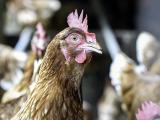Aug 29, 2006 (CIDRAP News) – Final tests confirmed that two mute swans in Michigan had a mild strain of H5N1 avian influenza virus, not the lethal Asian variety, the US Department of Agriculture (USDA) announced yesterday.
Authorities discovered the virus in the wild swans, which appeared healthy, when they were sacrificed on Aug 8 and tested in conjunction with a population-reduction plan at a game area on Lake Erie in southeastern Michigan. Initial tests detected an H5 virus along with an N1 subtype, but experts weren’t sure if the birds were infected with two separate avian flu strains or if the findings represented low-pathogenic H5N1.
The testing, done at the USDA National Veterinary Services Laboratories in Ames, Iowa, detected the "North American strain" of low-pathogenic H5N1 in one of 20 samples collected from the two swans, according to a USDA press release. Preliminary test results on Aug 14 indicated that an H5N1 strain could be present in two of the samples, but only one sample contained enough of the virus to permit testing.
Low-pathogenic avian flu viruses are common in wild birds and typically cause minor illness or no signs of disease. The mild form of H5N1 has been found several times in wild birds in North America and poses no threat to humans, the USDA said.
In other avian flu news, the US Environmental Protection Agency (EPA) recently released a disposal guide for handling chickens and other domestic birds infected with avian flu. The guide discusses topics such as roles during disposal activities, carcass management, equipment cleaning and disinfection, transportation, and protective equipment. Though the USDA is the lead federal agency in responding to large-scale animal carcass disposal, the EPA provides technical assistance and support for decontamination and disposal issues.
In Vietnam, health officials said yesterday that the H5N1 virus was found on a small duck farm in the southern Ben Tre province, according to a Reuters report. The source of the infection is not known. An animal health official in the district told Reuters that all 84 ducks were culled and that ducks on 14 nearby farms tested negative for the disease. An H5 virus resurfaced in ducks and storks in the past month, but no human H5N1 infections have been reported in Vietnam since December, the Reuters report notes.
Meanwhile in the Netherlands, testing of two northern hawk owls that were found dead at a Rotterdam zoo did not confirm that they died of H5N1 avian flu, according to a Dutch government report posted 2 days ago on ProMED-mail, the Internet-based reporting system of the International Society for Infectious Diseases. Two rounds of testing raised suspicions about the presence of the H5N1 in the birds, but investigators have not been able to isolate the virus.
See also:
Aug 28 USDA press release on negative H5N1 test results in Michigan mute swans



















